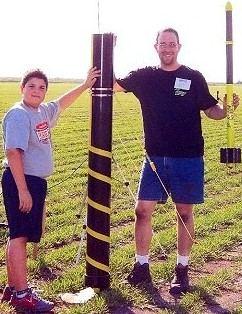Scratch Tu-Be or Not Tu-Be Original Design / Scratch Built
Scratch - Tu-Be or Not Tu-Be {Scratch}
Contributed by Scott Simka
| Manufacturer: | Scratch |
 Brief:
Brief:
My level 1 project evolved from a working prototype design that was inspired by
a series of ROL posts. The project was to fire a rocket (centered with sabots,
shown at right) from within a vertical tube which was anchored to the ground.
The sabots would need to fall away from the rocket upon its exit from the
launch tube.
Design Specs:
- Diameter: 2 inches
- Length: 45 inches
- Weight: 42 oz (flight ready)
- Motor mount: 29mm
- 6 tube-fins
- "Arizona" energy drink bullet top nosecone
- 12 foot X 4mm shock cord from REI
- Custom made Centering Rings from 1/2 inch Plywood
- Anti-zipper design, with stuffer tube and baffle
Months of trial and error and some good luck led me to obtain a 6 foot section of 6 inch commercial sewer pipe as well as the right sized poster tube that would fit to within 1/8 inch of it's internal diameter. In addition, the Styrofoam packaging from a zoom lens became my sabots. The 2 equal halves also just fit into the pipe with less than 1/8 inch of space but still moved freely up and down.
 Construction:
Construction:
The poster tubes were cut: 6 x 4 inch fins and 2 body sections. All were
glassed with 1.5 oz cloth. The Arizona Bullet top Nosecone replaced the Edge
Shaving Cream Cover from the prototype. It required a series of plywood discs
to be turned on the end of a drill to match the inner shape of the cone and fit
within the body tube. These would hold the eyebolt and attach to the forward
body tube.
The 3 centering rings needed to fill the 1/4 inch space between the MMT and the Body Tube, and were just larger than the width of the 2-6 inch #4 threaded rods that ran through them.
The Tube fins were glassed individually then all tubes were wet sanded numerous times and then primed and painted. Before the final coat, they were filed down, attached in pairs, and then the pairs were epoxied to the frame. The leading edge of the tube fins were beveled inward. Glossy black grill paint rated to 600 degrees was utilized on the rocket too.
There was no launch lug or rail button! A piece of rubber hose connector was epoxied just forward of the CG. The flattest edge faced forward and had a 1/4 inch width around the airframe.
 The 2
sabots were hollowed through their length and their bottom would rest on the
piece of rubber hose connector. The nose of each sabot was beveled at a 45
degree angle. They separate upon exit from the tube. The Styrofoam sabot
surfaces were "glued and tissued" and then latex painted fluorescent
yellow.
The 2
sabots were hollowed through their length and their bottom would rest on the
piece of rubber hose connector. The nose of each sabot was beveled at a 45
degree angle. They separate upon exit from the tube. The Styrofoam sabot
surfaces were "glued and tissued" and then latex painted fluorescent
yellow.
For shock cord material I used REI's 4mm orange utility cord. Since I couldn't find a U-Bolt to fit my homemade bulkhead, I made one from braided steel cable with aluminum clamps in back. A Bowline with 2 half hitches was CA'd and looped through the eyebolt in the nose and quicklink at the bulkhead. Directly behind the bulkhead, the stuffer-tube with baffle ended.
When assembled, the rocket with sabots could slide up and down very easily within the pipe. The pipe was secured with a series of conduit clamps held in place by 2 large threaded pipe straps/clamps. Through the conduit clamps, went tent guy wires and were pegged into the ground. A plywood disk would fit into the bottom of the tube to keep from scorching the grass. Holes were drilled in the bottom edge of the pipe in order to stick the igniter wires through.
The decal was made on my PC's printer with a transparency sheet and was epoxied to the airframe.
Flights:

My initial Certification attempt utilized nuts and washers to hold the 29/180-H128-10 in place. The ejection charge blew the motor out the back, bending the threaded rod. The angle of the washers led to the bent threaded rod.
Two Mirror clamps, trimmed and drilled, fit over the threaded rod and over the lip of the forward closure and securely held my replacement motor casing squarely. The second attempt was successful.
I had great glassing and finishing help from Stephen Ruane and development ideas from Ray Dunakin and Rick Dunseith all via email.
I also wish to thank all those who shared their knowledge on the ROL forums, as well as Rick Boyette, Mark Bernet and Robb Haskins from our club Florida Spacemodeling Association-Tripoli West Palm.
Sponsored Ads
 |
 |











